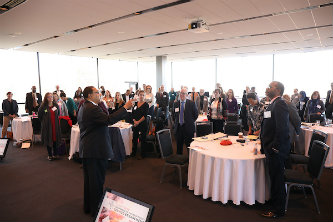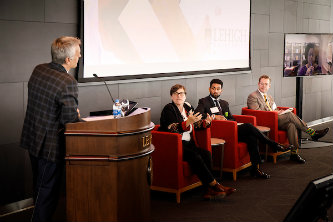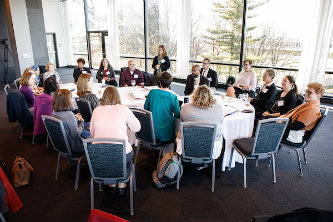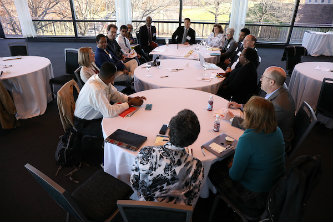Lehigh Hosts Summit on Faculty Service Engagement
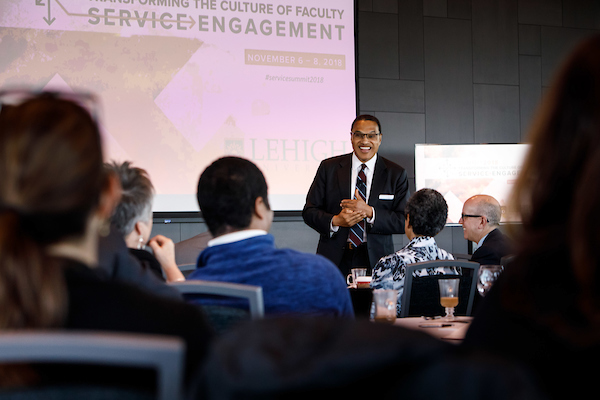
Freeman A. Hrabowski III, president of the University of Maryland Baltimore County, delivered the keynote at Summit 2018: Transforming the Culture of Faculty Service Engagement at Lehigh.
About 80 leaders in American higher education attended Summit 2018: Transforming the Culture of Faculty Service Engagement at Lehigh on Nov. 6-8. Participants included presidents, provosts and assistant provosts, senior diversity officers, deans, chairs and faculty members of colleges, universities and disciplinary professional societies.
Lehigh’s Office of the Provost and the Office of Diversity, Inclusion and Equity partnered to host the national summit, which aimed to explore the definition and value of faculty service and engagement; contribute to strategies to address equity in faculty workloads and rewards; and determine how to effectively integrate this work into the range of responsibilities for a fully successful and engaged faculty.
“To our knowledge, this is the first multidisciplinary gathering of national reach focused solely on aspects of faculty service and engagement for the purposes of building a community to continue clarifying the value of and necessary infrastructure to support this work equitably,” said Marci Levine, director of the Lehigh ADVANCE Center and co-chair of the Summit planning team.
A Tuesday evening welcome dinner in the Iacocca Tower Room kicked off the event. Wednesday began with a welcome from Provost Pat Farrell in the Wood Dining Room.
Farrell outlined the importance of the topic of faculty service and engagement, noting that colleges and universities seek to use faculty and staff time effectively, but some types of service are easier to assess than others.
“In my view, the broad, broad topic of service engagement tends to be in that category of difficult to quantify. [It is] not always well-defined what the objectives are at the outset, and therefore, in some cases, if not dismissable, then at least easily discounted. The temptation is to emphasize things that we know how to document, how to count. [That] doesn’t make it less important, but it is in my view a thing to recognize,” he said.
Farrell noted that when thinking about the challenges around faculty service and engagement, he thinks of three questions: “How is it decided what service work needs to be done and who should do it? … How do we assess and acknowledge the contribution of this work to the institution’s overall mission? …How do we acknowledge the time and energy that goes into this work—and clearly then does not go into other work that is also important—and can we do this in a way that is sustainable?”
He then introduced keynote speaker Freeman A. Hrabowski III, president of the University of Maryland Baltimore County (UMBC), who spoke about “The Meaning and Value of Faculty Service and Engagement in Higher Education.”
Hrabowski, who has served as president of UMBC since 1992, specializes in science and math education with an emphasis on minority participation and performance. He was named by President Obama to chair the President’s Advisory Commission on Educational Excellence for African Americans, and was also named one of the 100 most influential people in the world by Time in 2012 and one of America’s best leaders by U.S. News and World Report in 2008. Hrabowski’s most recent book, Holding Fast to Dreams: Empowering Youth from the Civil Rights Crusade to STEM Achievement, describes the events and experiences that led to his development of programs that promote educational success in the STEM fields for African Americans.
Hrabowski began by encouraging honest dialogue.
“It seems to me the question is, ‘How do we go from the common knowledge—what we all agree on—to the hard questions and to honest conversation about what can be done, what approaches have been working so far?’” he said.
Hrabowski called attention to the convenience of calling on those in higher education who are comfortable saying “yes,” and how those individuals are often women and people of color. Those who frequently volunteer, he said, are penalized “years later, when it’s time for the rewards,” while those who do not volunteer see more success and receive all the benefits. Clear expectations, he said, are critical.
“One of the most important things that we learned in our ADVANCE work [at UMBC] is that clear expectations are critical because it’s so easy to assume everybody’s on the same page. And you’re bringing women, people of color and others, and people have the best of intentions. And if your expectations are not clear, people will do the work they consider most important from a … position of authenticity. But the story that we all tell—that we all know—is that there have been women and people of color who come in and do so much to help the institution, and years later, when it’s time for tenure, people tell them goodbye. And there's a disconnect somehow. … And so one of my challenges to us in American higher education is simply to be honest about what happens, and to use language that quite frankly will not simply be off-putting or make people defensive, but language that may help to pull people into the thinking, to be willing to talk about the issue.”
Hrabowski discussed UMBC’s efforts to address the problem, which include engaging in difficult conversations with departments about workload and reward, partnering with other universities, and various initiatives related to post-family leave faculty research reintegration, course release time, research and graduate student support, domestic and international travel grants, and opportunities to accelerate faculty research productivity and provide time away from service.
“The number one goal of a conference like this would be to give support to the people who really are trying to help students and their campus and people in the communities. How do we give them support and have them knowing not just that we care, but that we in different ways put our rewards where that language is? That’s the fundamental point.
“One of the things I say that’s controversial to young minority faculty is that I know they want to ... help [African American and Hispanic] students out, but they have to decide how much time they can give to that on the outside. We’ve got to have honest conversations about that. What does that mean? As I've said to a number of our colleagues, if you build it, it will come. The more you seem welcoming and supportive, the more students will come and want that time. And the question is, how can you be supportive but move that student to a counselor or an adviser whose job it is to do that? Because while you may do it well, I’m saying to young faculty, it is not that activity of hours and hours that will help you to be at the institution long term so that you can continue to do it. And seems to be very important, when thinking about clear expectations, that we have those conversations with women faculty, people of color, but [also] other faculty members regardless of race and gender who are interested in the service aspect.”
Hrabowski emphasized the importance of examining an institution’s culture.
“Culture has everything to do with those things we value the most, the incentives that we use to get people to do things, the questions that we ask, the questions we’re not comfortable in asking, the way we go about assessing for evaluating, and, most important, the level of honesty and authenticity [we have] about who we are,” he said. “The reason I say [to] go beyond the culture of faculty service or engagement is it’s not just for the service that's going on, it’s how does it fit with the bigger picture of the university or the college? What is the culture of that institution? How does what we talk about in terms of service and engagement fit into the overall culture? What is its role when we think about service or engagement?”
The goal, Hrabowski said, “really is about transforming the culture of the entire institution of American higher education.”
After the keynote, the program’s speakers, workshops and break-out sessions invited participants to explore the existing service-engagement landscape and brainstorm ways to foster excellent and sustainable mutual benefits of this type of work. Current research highlighted the causes and consequences of gender and racial inequities in typical service assignments. Participants considered both formal and informal types of service and difficult-to-measure impacts of faculty service and engagement. Workshops led by KerryAnn O’Meara, associate dean for faculty affairs and graduate studies in the College of Education at the University of Maryland as well as professor of higher education and director of the university’s ADVANCE Program, inspired attendees to rethink service-engagement by implementing specific tools for investigating their local faculty work-load practices and to make service more transparent because of the subjective perceptions of equity. Participants also examined how faculty evaluation criteria related to engagement as well as resources to foster successful scholars of engagement might be reframed and rewarded. Even though attendees were from different disciplines and institution types, the combination of theory, practice and deep conversations helped participants converge on a common belief that service and engagement were important pathways to faculty retention. The summit culminated in some important recommendations:
Individual Actions:
· Share what was learned at the summit with five people on your campus, including senior academic officer
· Participate in future activities related to transforming systems of service-engagement
Systemic Actions:
· Establish locally relevant, operationalized definitions (taxonomy) of service and engagement with clear standards and criteria
· Make service and engagement visible and aligned with organizational goals
· Reduce unnecessary committees and committee memberships to the level necessary to complete the task.
· Implement credit systems (incentives) to support broader distribution of faculty service work tied to policies or practices to facilitate equity
· Try pilot programs and audit practices (leveraging current research and summit resources) to create incremental change
· Develop case studies of integrated scholarship/engagement and integrated teaching/scholarship for faculty development
· Develop a service ‘impact factor’ for faculty reappointment/promotion similar to what is used in research and teaching evaluation
· Harness professional societies to create disciplinary norms, guidelines, and expectations for valuing service and engagement
· Broadly disseminate best practices and recommendations through publications and convenings of higher education leaders
“The Summit has successfully laid the foundation for the transformation of faculty tenure and promotion as it relates to the value of faculty service and engagement,” said Lehigh’s Henry Odi, deputy vice president for equity and community, associate provost for academic diversity, and co-chair of the Summit planning team.
Photos by John Kish
Posted on:


